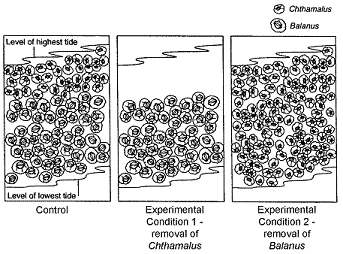Experimental Condition 1 of the accompanying figure, the distribution of Balanus suggests: that
 In
In
a. interspecific competition kept Balanus from extending higher into the intertidal area.
b. intraspecific competition kept Balanus from extending higher into the intertidal area.
c. an unfavorable environmental factor kept Balanus from extending higher into the intertidal area.
d. Balanus is less motile than Chthamalus.
e. Balanus is more motile than Chthamalus.
c
You might also like to view...
Which of these is a correct representation of the hierarchy of biological organization from least to most complex?
A) organelle of a stomach cell, digestive system, large intestine, small intestine, intestinal tissue, organism B) organelle of an intestinal cell, digestive system, small intestine, large intestine, intestinal tissue, organism C) molecule, intestinal cell organelle, intestinal cell, intestinal tissue, digestive system, organism D) molecule, small intestine, large intestine, intestinal tissue, digestive system, organism E) molecule, digestive system, digestive cell organelle, small intestine, large intestine, intestinal cell, organism
Chiasmata form during which phase of meiosis?
a. prophase I b. metaphase I c. telophase I d. prophase II e. metaphase II
The resting membrane potential is indicated by
a. A. b. B. c. C. d. D. e. E.
The common house mouse species, Mus musculus, has the following taxonomic classification: Mus, Muridae, Rodentia, Mammalia, Chordata, Animalia, Eukarya. Which part of the name is the Family?
A. Muridae B. Chordata C. Animalia D. Rodentia